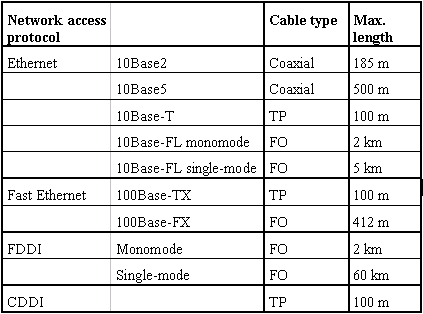

|
|
Initiation responsibility: Head of IT Section
Implementation responsibility: Network planner; Head of Site/Bldg Technical Service
From the communications technology standpoint, the choice of cable is determined by, among other things, the required data transfer rate (bandwidth) and the distances to be covered without repeaters. The requirements arising from the structural conditions at the installation location also have to be taken into account when making the selection. In the following, the respective advantages and disadvantages are described from an IT security point of view.
At present there can be considered to be two types of transmission media for cable (as opposed to wireless) communications: copper cable or an optical medium (optical fibre (FO)). Both of these types of media can be further divided into various subcategories. The most important of these for the medium of copper are the coaxial cable (one centre conductor with overall screening) and the multi-core copper cable with the wires twisted in pairs (twisted-pair cable, TP cable). These are explained in more detail below.
Twisted-pair cable
Twisted-pair cables are available in many different forms. These differ on the one hand according to the nature of their shielding and on the other according to their potential bandwidth. The current shielding classes are as follows:
In addition to their shielding designations, TP cables are divided into categories according to their bandwidth and other electrical properties, currently categories 1 to 5. A draft standard has been drawn up for categories 6 and 7. The rule here is: the higher the category, the higher the possible bandwidth. The bandwidth is determined by various physical properties of the cable. The commonly used UTP or STP cables in categories 3 to 5 can be used to transfer between 10 and 100 Mbit/s over a maximum length of 100 m with Ethernet or Fast Ethernet, while up to 155 Mbit/s can be transferred on category 5 cables with ATM. Cables in category 6 will have a bandwidth of 600 MHz and therefore allow data transfer rates of up to 1 Gbit/s.
TP cables are at present mainly used for star-type cabling and in some cases also for ring-type cable configurations.
Advantages:
Disadvantages:
Coaxial cable
Coaxial cables are mainly used for bus cabling or for connecting the network nodes in tree structures, for example. Thanks to the overall screening of the centre conductor, it can generally be assumed that the electromagnetic compatibility (EMC) of these cables is good.
Advantages:
Disadvantages:
Optical fibres (FO)
Optical fibre cables use light in the visible to far infrared range for the transmission of signals. The structure of an optical fibre cable is similar to that of a coaxial cable. The actual optical fibre in the centre is surrounded by cladding, the optical properties of which are different from those of the core. Around the whole of this is another sheath to provide protection against mechanical and optical influences. Optical fibres are available in two versions: multimode and single-mode optical fibres. These two types differ primarily in terms of the possible bandwidth and the maximum length that can be attained without additional repeaters.
Optical fibre cables are generally used for bridging long distances (for example connections between buildings or floors) in a backbone, and in some cases in dual ring systems.
Advantages:
Disadvantages:
An overview of the length restrictions on cables for some of the common protocols (Ethernet, Fast Ethernet, FDDI and CDDI; cf. S 5.60 Selection of a suitable backbone technology) is given in the table below:

It should be noted that the lengths stated above are the maximum lengths in each case. This is often made up of the installation cable itself and the connecting cables (patch cables). For 10Base-T, for example, the length of the installation cable should therefore not exceed 90 m so as to leave sufficient length for patch cables. With some procedures (such as 100Base-FX) the length is reduced by the use of repeaters, depending also on the type of repeaters.
When installing new networks it makes sense to use optical fibres in the primary and secondary areas because they will be able to satisfy future requirements thanks to the high available bandwidth. For the tertiary area it needs to be examined whether the use of TP cables or optical fibres is possible and/or necessary according to technical and security criteria, and also whether it is justifiable from the economic standpoint (cf. also S 5.2 Selection of an appropriate network topography).
| © Copyright
by Bundesamt für Sicherheit in der Informationstechnik |
July 1999 |